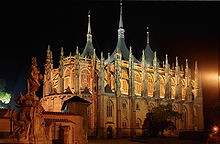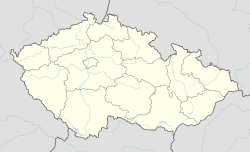St. Barbara's Church, Kutná Hora
This article has multiple issues.Please helpimprove itor discuss these issues on thetalk page.(Learn how and when to remove these messages)
|
| St. Barbara's Church, Kutná Hora | |
|---|---|
Chrám svaté Barbory | |
 | |
| 49°56′42″N15°15′49″E/ 49.94500°N 15.26361°E | |
| Country | Czech Republic |
| Denomination | Roman Catholic |
| Website | www |
| Architecture | |
| Architect(s) | František Maxmilián Kaňka |
| Style | Gothic Neo-Gothic |
| Administration | |
| Diocese | Diocese of Hradec Králové |
| Official name | Kutná Hora: Historical Town Centre with the Church of St Barbara and the Cathedral of Our Lady at Sedlec |
| Location | Europe |
| Criteria | ii, iv |
| Reference | 732 |
| Inscription | 1995 (19thSession) |
Saint Barbara's Church(Czech:Chrám svaté Barbory) is a RomanCatholic ChurchinKutná Hora(Bohemia) in the style of acathedral,and is sometimes referred to as the Cathedral of St Barbara (Czech:Katedrála sv. panny Barbory).[1]It is one of the most famous Gothic churches in central Europe and it is aUNESCOWorld Heritage Site.St Barbarais thepatron saintof miners (among others), which was highly appropriate for a town whose wealth was based entirely upon its silver mines.
Construction began in 1388,[2]but because work on the church was interrupted several times, it was not completed until 1905. The first architect was probablyJohann Parler,son ofPeter Parler.[2]Work on the building was interrupted for more than 60 years during theHussite Warsand when work resumed in 1481,Matěj Rejsek,Benedikt Rejtand Mikuláš Parler, assumed responsibility.[2]
The original design was for a much larger church, perhaps twice the size of the present building. Construction, however, depended on the prosperity of the town's silver mines, which became much less productive. So, in 1588, the three-peaked roof had been completed,[2]and a provisional wall was constructed. A little later it was occupied byJesuitswho gradually changed the structure intoBaroque style,though parts still remain inGothic style.[2]
The final process of repair and completion took place at the end of the 19th century, under architects J. Mocker and L. Labler.[2]
Originally there were eight radial chapels with trapezoidal interiors. Later on, the choir was constructed, supported by double-archedflying buttresses.
Internal points of note are the glass windows, altars, pulpits and choir stalls. Medieval frescoes depicting the secular life of the medieval mining town and religious themes have been partially preserved.
Gallery
[edit]-
Front view
-
Interior
-
Ceiling Vault
-
Stained glass depicting emperor Franz Joseph I






